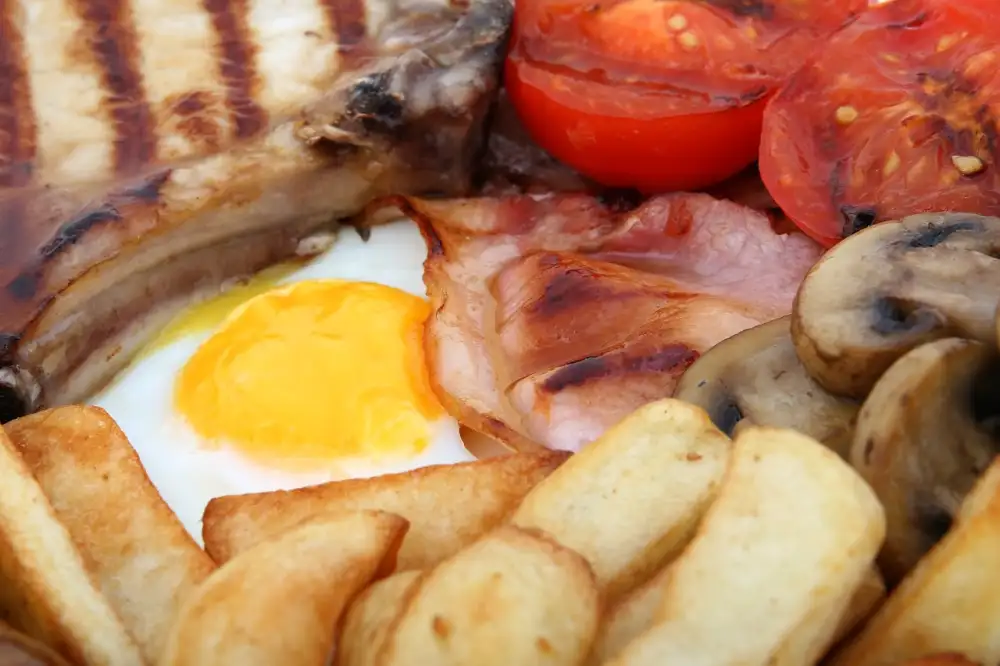Discover the Art of Good Chop: Uncover the Secrets to Quality Cuts of Meat

- Understanding the Importance of Quality Cuts in Culinary Delights
- Differentiating Between Various Cuts of Meat and Their Characteristics
- Exploring Popular Cuts: Tenderloin, Ribeye, and Sirloin
- Unveiling the Secrets of Flavorful Cuts: T-Bone and Porterhouse
- Lesser-Known Gems: Flat Iron and Hanger Steak
- Tips for Selecting and Preparing Quality Cuts of Meat
- Enhancing the Flavor: Seasoning and Cooking Techniques for the Perfect Chop
- Pairing Quality Cuts with Complementary Ingredients and Sauces
When it comes to creating mouthwatering culinary delights, one cannot underestimate the importance of quality cuts of meat. The art of a good chop lies in selecting the right cut that not only enhances the flavor but also ensures tenderness and juiciness. From tenderloin to ribeye, each cut has its own unique characteristics that contribute to a truly exceptional dining experience. Join us on this flavorful food adventure as we delve into the world of quality cuts and uncover the secrets behind a perfect "good chop".
Understanding the Importance of Quality Cuts in Culinary Delights
When it comes to creating culinary masterpieces, the quality of the ingredients used plays a crucial role. And when it comes to meat, nothing beats the importance of selecting quality cuts.
Quality cuts of meat not only ensure tenderness and juiciness but also contribute significantly to the overall flavor profile of a dish. The texture, marbling, and fat content all come together to create a delightful eating experience that is sure to tantalize your taste buds.
Whether you're grilling, roasting, or braising, using high-quality cuts will elevate your dishes to new heights. The tenderness of a well-marbled ribeye or the succulence of a perfectly cooked tenderloin can turn an ordinary meal into an extraordinary one.
Investing in quality cuts also means supporting responsible farming practices and animal welfare. By choosing ethically sourced meats from reputable suppliers, you can ensure that you are not only enjoying delicious food but also making a positive impact on the environment and our food system.
So next time you're planning a culinary adventure, remember that quality cuts are the foundation of any great dish. From enhancing flavors to supporting sustainable practices, they truly make all the difference in creating unforgettable dining experiences.
Differentiating Between Various Cuts of Meat and Their Characteristics
When it comes to quality cuts of meat, it's important to understand the different types and their characteristics. Each cut offers a unique flavor profile and texture, making them suitable for various culinary creations.
One popular cut is the tenderloin, known for its tenderness and mild flavor. It is lean and best suited for dishes that require quick cooking methods like grilling or pan-searing.
The ribeye, on the other hand, is prized for its rich marbling and intense beefy flavor. This cut is perfect for those who enjoy a juicy and flavorful steak. It can be cooked using various methods such as grilling, broiling, or pan-frying.
Another well-known cut is the sirloin, which offers a balance between tenderness and flavor. It has a slightly firmer texture compared to tenderloin but still delivers great taste. Sirloin works well in stir-fries, kebabs, or even as a roast.
For those looking for an indulgent experience, the T-bone and porterhouse cuts are excellent choices. These cuts include both the tenderloin and strip loin sections separated by a T-shaped bone. They offer a combination of tenderness from the tenderloin and robust flavor from the strip loin.
Moving on to lesser-known gems, we have the flat iron steak. This cut comes from the shoulder area of the cow and boasts exceptional tenderness with a rich beefy flavor. It can be grilled or pan-seared to perfection.
Lastly, there's the hanger steak, also known as "butcher's steak." It has a strong beefy flavor and a coarse texture. Marinating this cut enhances its tenderness before grilling or broiling.
Understanding these different cuts of meat allows you to choose wisely based on your desired taste and cooking method. Whether you prefer tenderness or bold flavors, there's a perfect cut waiting to elevate your culinary creations.
Exploring Popular Cuts: Tenderloin, Ribeye, and Sirloin
When it comes to popular cuts of meat, three names often come to mind: tenderloin, ribeye, and sirloin. These cuts are beloved by chefs and food enthusiasts alike for their exceptional flavor and tenderness.
The tenderloin, also known as filet mignon, is renowned for its melt-in-your-mouth texture. This cut comes from the loin area of the animal and is incredibly lean. It is prized for its tenderness and mild flavor, making it a favorite choice for special occasions.
Ribeye, on the other hand, is known for its rich marbling and intense beefy flavor. Cut from the rib section of the animal, this steak offers a perfect balance of tenderness and juiciness. The marbling not only enhances the taste but also keeps the meat moist during cooking.
Sirloin is another popular cut that comes from the back of the animal near the hip area. It is slightly less tender than tenderloin or ribeye but makes up for it with its robust flavor. Sirloin steaks are versatile and can be cooked using various methods such as grilling, pan-searing, or broiling.
Each of these popular cuts has its own unique characteristics that cater to different preferences. Whether you prefer a lean and tender bite or a well-marbled piece bursting with flavor, there's a cut out there to satisfy your palate.
Unveiling the Secrets of Flavorful Cuts: T-Bone and Porterhouse
When it comes to flavorful cuts of meat, the T-Bone and Porterhouse steaks are truly in a league of their own. These cuts are known for their combination of tenderloin and strip loin, making them a favorite among steak enthusiasts.
The T-Bone steak is named after its distinctive T-shaped bone that separates the two cuts. On one side, you have the tenderloin, which is incredibly tender and lean. On the other side, you have the strip loin, which is slightly fattier but equally delicious. This combination allows for a variety of textures and flavors in every bite.
The Porterhouse steak takes this concept to another level by featuring an even larger portion of tenderloin. In fact, it is often considered the king of steaks due to its generous size and succulent taste. The Porterhouse offers the best of both worlds - a melt-in-your-mouth tenderloin and a richly marbled strip loin.
To bring out the full potential of these cuts, proper cooking techniques are crucial. Grilling or pan-searing at high heat is recommended to achieve a beautiful sear on the outside while keeping the inside juicy and tender. It's important to let these steaks rest after cooking to allow the juices to redistribute evenly throughout.
Whether you choose a T-Bone or Porterhouse steak, be sure to season it generously with salt and pepper before cooking. This will enhance the natural flavors of the meat without overpowering them.
To further elevate your culinary experience with these flavorful cuts, consider pairing them with complementary ingredients and sauces. A classic choice would be serving them with sautéed mushrooms or a rich red wine reduction sauce. The earthy flavors of mushrooms or the depth of a well-reduced sauce can beautifully complement the robust taste of T-Bone or Porterhouse steaks.
In conclusion, if you're looking for an unforgettable dining experience, look no further than T-Bone and Porterhouse steaks. These cuts offer a perfect balance of tenderness, marbling, and flavor. With the right cooking techniques and complementary ingredients, you can unlock the secrets to truly flavorful chops that will leave your taste buds craving for more.
Lesser-Known Gems: Flat Iron and Hanger Steak
When it comes to quality cuts of meat, most people immediately think of the popular choices like tenderloin, ribeye, and sirloin. However, there are a few lesser-known gems that deserve some recognition: the flat iron and hanger steak.
The flat iron steak, also known as a top blade steak, is cut from the shoulder area of the cow. It is incredibly tender and flavorful, with a rich marbling that adds to its succulence. This cut has gained popularity in recent years due to its affordability and versatility in various cooking methods.
On the other hand, hanger steak is a unique cut that hangs between the rib and loin sections of the cow. It is known for its robust flavor and tender texture. Although it may require some trimming before cooking, hanger steak rewards you with a delicious eating experience.
Both flat iron and hanger steak offer an excellent balance between tenderness and flavor. They are perfect for grilling or pan-searing to achieve a beautiful caramelized crust while maintaining juiciness on the inside. These cuts can be enjoyed on their own or used in dishes like fajitas, stir-fries, or salads.
Next time you're at your local butcher or meat counter, don't overlook these hidden treasures. Give flat iron and hanger steak a try, and you'll discover new dimensions of taste in your culinary adventures.
Tips for Selecting and Preparing Quality Cuts of Meat
When it comes to selecting and preparing quality cuts of meat, there are a few tips to keep in mind. Firstly, always choose meat that is bright red in color with marbling throughout. This marbling indicates a good amount of fat, which adds flavor and tenderness to the meat. Secondly, consider the source of the meat. Look for cuts from reputable suppliers or local farmers who prioritize animal welfare and sustainable practices. Additionally, pay attention to the age of the meat. Younger animals tend to produce more tender cuts. Lastly, when preparing your chosen cut, be sure to follow proper cooking techniques such as searing or slow-cooking depending on the type of meat. This will ensure that you bring out the best flavors and textures in your dish. By following these tips, you can elevate your culinary experience with the perfect "Good Chop".
Enhancing the Flavor: Seasoning and Cooking Techniques for the Perfect Chop
Enhancing the flavor of a quality cut of meat is essential to creating the perfect chop. Seasoning plays a crucial role in bringing out the natural flavors of the meat. A simple combination of salt, pepper, and garlic powder can work wonders. However, don't be afraid to experiment with different herbs and spices to add depth and complexity.
When it comes to cooking techniques, there are several options to consider. Grilling is a popular choice as it imparts a smoky flavor and creates beautiful grill marks. Pan-searing is another great technique that locks in the juices and creates a delicious crust on the outside.
For those who prefer a more tender and juicy chop, consider marinating the meat before cooking. A marinade made with ingredients like soy sauce, Worcestershire sauce, olive oil, and herbs can infuse the meat with incredible flavors.
Additionally, using proper cooking temperatures is vital for achieving the perfect chop. Overcooking can result in dry and tough meat, while undercooking may leave it raw in the center. Invest in a good meat thermometer to ensure accurate cooking times.
Remember that resting your cooked chop is just as important as cooking it properly. Allowing the meat to rest for a few minutes after cooking helps redistribute its juices, resulting in a more flavorful and tender bite.
By mastering seasoning techniques and choosing appropriate cooking methods, you can elevate the flavor of your quality cuts of meat to create an unforgettable dining experience.
Pairing Quality Cuts with Complementary Ingredients and Sauces
Pairing quality cuts of meat with complementary ingredients and sauces is essential to create a harmonious and flavorful culinary experience. When selecting ingredients, consider the flavor profile of the meat. For tenderloin, a delicate cut, opt for lighter accompaniments like fresh herbs, citrus zest, or a simple pan sauce. Ribeye, with its rich marbling, pairs well with bold flavors such as blue cheese, caramelized onions, or a red wine reduction. Sirloin benefits from robust spices like garlic, rosemary, or a tangy chimichurri sauce. Experimenting with different combinations will elevate your "good chop" to new heights of deliciousness.
In conclusion, understanding the art of a good chop and uncovering the secrets to quality cuts of meat can truly elevate your culinary experience. By selecting the right cut, preparing it with care, and pairing it with complementary ingredients and sauces, you can create a flavorful masterpiece that will delight your taste buds. Whether it's a tenderloin, ribeye, sirloin, T-bone, porterhouse, flat iron, or hanger steak, each cut offers its own unique characteristics and flavors. So next time you're in the kitchen, take the time to explore different cuts of meat and unlock the potential for an unforgettable dining experience.
Published: 07. 12. 2023
Category: Food



